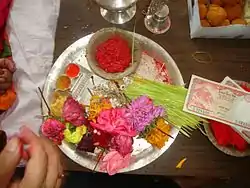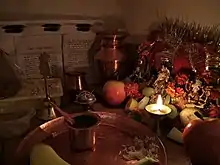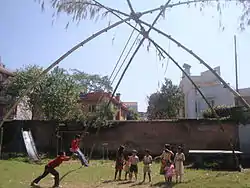Dashain
Dashain (Dashain, Nepal or Baḍadasai बडादशैँ), also Bijaya Dashami) is a festival originating from Nepal. In other parts of South Asia, it is called Dashain.[1] Dashain is celebrated by the Hindus of Nepal and the Nepali language speaking people of the Darjeeling hills, Sikkim, Siliguri, Assam and other North-Eastern states of India[2] and among the Lhotshampa of Bhutan[3] and the Burmese Gurkhas of Myanmar. Many people of Nepal celebrate this festival.
| Dashain | |
|---|---|
| Also called | Bijaya Dashami |
| Observed by | Nepali Hindu religion |
| Type | Religious, Cultural |
| Significance | Celebrates the victory of good over evil |
| Celebrations | Marks the end of Durga Puja |
| Observances | People worship Kali, Chandi, Bhairabi, Barahi and take the tika and jamara with elders, pandals (stages), plays, community gathering, recitation of scriptures, immersion of Durga or burning of Ravana. |
| Date | Ashvin or Kartik (September or October) |
It is the longest and the most auspicious festival in the Bikram Sambat and Nepal Sambat annual calendars, celebrated by Nepalese people, along with their diaspora throughout the globe. It is the most anticipated festival in Nepal, Bhutan, Burma, and North Indian hills. People return from all parts of the world, as well as different parts of the country, to celebrate together.[2] All government offices, educational institutions, and other offices remain closed during the festival period. The festival falls in September or October, starting from the shukla paksha (bright lunar fortnight) of the month of Ashwin and ending on Purnima, the full moon. Among the fifteen days on which it is celebrated, the most important days are the first, seventh, eighth, ninth, tenth, and fifteenth.[4]
Among the Newar of the Kathmandu Valley, during the Dashain festival, a popular Newari festival called Mohani, is celebrated as the most important festival of Nepal Sambat calendar year.[5] Among Hindu and Buddhist Newars, it is celebrated differently, where each nine days Navaratri (Nepal Bhasa: नवरात्री) leading up to the 10th day called 'Dashami', carry special importance.[6] The goddess Durga and her various manifestations are especially worshiped by Newars throughout the Shaktipeeths of Kathmandu Valley. Among Newars, Dashain is also important for its emphasis on family gatherings as well as on a renewal of community ties, highlighted by special family dinners called Nakhtyā (Nepal Bhasa: नख्त्या) and various communal processions of deities called Jātrā (Nepal Bhasa: जात्रा) throughout the three royal cities of Kathmandu Valley.[2]
Significance
Dashain symbolizes the victory of good over evil.
For followers of Shaktism, it represents the victory of the goddess Durga. In Hindu mythology, the demon Mahishasura had created terror in the devaloka (the world where gods lives) but Durga killed the rakshas (demon).[7][8][9] The first nine days of Dashain symbolize the battle which took place between the different manifestations of Durga and Mahishasura. The tenth day is the day when Durga finally defeated him. For other Hindus, this festival symbolizes the victory of Ram over Ravan as recounted in the Ramayana.
Day 1: Ghatasthapana Dashain

Ghaṭasthāpanā (घटस्थापना "sowing Jamara") marks the beginning of Dashain.[10][11] Literally, it means placing a kalasha or a pot, which symbolizes goddess Durga. Ghaṭasthāpanā falls on the first day of the festival. On this day the Kalash is filled with holy water and is then sewn with barley seeds. Then the Kalash is put in the center of a rectangular sand block. The remaining bed of sand is also seeded with grains. The priest then starts the puja by asking Durga to bless the vessel with her presence. This ritual is performed at a certain auspicious time which is determined by the astrologers.[12] The goddess is believed to reside in the vessel during Navratri.[13]
The room where all this is done is known as the Dashain Ghar. Traditionally, outsiders are not allowed to enter it. A family member worships the Kalash twice every day, once in the morning and then in the evening. The Kalash is kept away from direct sunlight[14] and holy water is offered to it every day so that by the tenth day of the festival the seed will have grown to five or six inches long yellow grass. This sacred grass is known as jamara. These rituals continue until the seventh day.
Day 7: Phulpati
Phulpati is a major celebration occurring on the seventh day of Dashain.
Traditionally, on this day, the royal Kalash, banana stalks, jamara, and sugar cane tied with red cloth is brought by Magars from Gorkha, a three-day walk, about 169 kilometres (105 mi) away from the Kathmandu Valley. Hundreds of government officials gather together in the Tundikhel grounds in conventional formal dress to witness the event. The king used to observe the ceremony in Tundikhel while the Phulpati parade was headed towards the Hanuman Dhoka royal palace. Then there is a majestic display of the Nepalese Army along with a celebratory firing of weapons that continues for ten to fifteen minutes honoring Phulpati. The Phulpati is taken to the Hanuman Dhoka Royal Palace by the time the occasion ends in Tundikhel, where a parade is held.[15]
Since 2008, when the royal family was overthrown, the two-century-old tradition is changed so that the holy offering of Phulpati goes to the residence of the president. The President has taken over the king's social and religious roles after the fall of the royal government.
Day 8: Maha Asthami
The eighth day is called Maha Asthami. This is the day when the most fierce of Goddess Durga’s manifestations, the bloodthirsty Kali, is appeased through the sacrifice of buffaloes, goats, hens, and ducks in temples throughout the nation. Blood, symbolic for its fertility, is offered to the Goddesses. Appropriately enough, the night of this day is called Kal Ratri(Black Night). It is also the norm for buffaloes to be sacrificed in the courtyards of all the land revenue offices in the country on this day. The old palace in Basantapur Hanuman Dhoka is active throughout the night with worships and sacrifices in almost every courtyard. On the midnight of the very day the Dashain Ghar, a total of 54 buffaloes and 54 goats are sacrificed in observance of the rites. After the offering of the blood, the meat is taken home and cooked as "prasad", or food blessed by divinity. This food is offered in tiny leaf plates to the household gods, then distributed amongst the family. Eating this food is thought to be auspicious. While the puja is being carried out, great feasts are held in the homes of common people. On this day Newar community has an event called "Khadga Puja" where they do puja of their weapons.
Day 9: Maha Navami
.png.webp)
The ninth day of Dashain is called Mahanavami, "the great ninth day". This is the last day of Navaratri. Ceremonies and rituals reach a peak on this day. On this day, official military ritual sacrifices are held in one of the Hanuman Dhoka royal palaces, the Kot courtyard. On this occasion, the state offers the sacrifices of buffaloes under the gunfire salutes. This day is also known as the demon-hunting day because members of the defeated demon army try to save themselves by hiding in the bodies of animals and fowls.
On Mahanavami, Vishvakarman, the god of creation, is worshipped as it believed that all the things which help us in making a living should be kept happy. Artisans, craftsmen, traders, and mechanics worship and offer animal and fowl blood to their tools, equipment, and vehicles. Moreover, since it is believed that worshipping the vehicles on this day avoids accidents for the year all the vehicles from bikes, cars to trucks are worshipped on this day.
The Taleju Temple gates are opened to the general public on only this day of the year. Thousands of devotees go and pay respect to the goddess this day. The temple is filled with devotees all day long.[16]
Day 10: Bijaya Dashami or Vijayadashami
The tenth day of the festival is the 'Vijayadashami'. On this day, a mixture of rice, yogurt and vermilion is prepared. This preparation is known as "tika". Often Dashain tika time[17] is different every year. Elders put this tika and jamara which is sown in the Ghatasthapana on the forehead of younger relatives to bless them with abundance in the upcoming years. The red also symbolizes the blood that ties the family together. Elders give "Dakshina", or a small amount of money, to younger relatives at this time along with the blessings. This continues to be observed for five days till the full moon during which period families and relatives visit each other to exchange gifts and greetings. This ritual of taking tika from all the elder relatives (even the distant relatives) helps in the renewal of the community ties greatly. This is one reason why the festival is celebrated with so much vigour and enthusiasm.
Day 15: Kojagrat Purnima
The last day of the festival which lies on the full moon day is called 'Kojagrat' Purnima. The literal meaning of Kojagrat is 'who is awake'. On this day Goddess Laxmi who is believed to be the goddess of wealth is worshipped as it believed that Goddess Laxmi descends on earth and showers whoever is awake all night with wealth and prosperity. People enjoy the night by playing cards and much more.

Animal sacrifices are often the norms during this time, as the festival commemorates the mythical bloody battles between the "divine" and "demonic" powers. The proponents of animal sacrifice interpret that this sacrificial act as the symbolic sacrifice of our animal qualities, but those who are opposed to animal sacrifice stress that the sacrificial act is nothing but an excuse to fulfill the appetite for food/meat.[18]
Forms of celebration

The Malshree dhun is incorporated into mainstream Nepalese music as the music of Dashain. It is the tune that announces the Dashain has arrived. Malashree dhoon is one of the oldest surviving devotional music of Newa art form, with its origin in the 17th century.[19] In due time and also the fact that Dashain happens to be celebrated not just by Newars but by all Nepalese, this dhoon caught up and now is part of the national culture and played during Dashain.

As Dashain approaches, kite flying becomes more and more common. Riding kites has been a very important part of celebrating Dashain in the country, as it is considered to be one way of reminding God not to send rain anymore.[20] During the festival people of all ages fly kites from their roofs. Colourful kites and voices shouting out 'changā chet' (this phrase is usually used when one cuts the other person's kite string) fill the days during the festival.
Playing cards is another way of celebrating Dashain.[20] While children are busy flying kites during Dashain, the older members of the family pass their time by getting together and playing cards with each other for money and fun.
Buying and wearing new clothes is an important part of the festival. As many people living in the villages are below the poverty line, for them it is often the case that new clothes come only with Dashain.[20] Almost all the shops have festival offers and discounts. This makes shopping more attractive. Clothes have the highest sales during the festival.[16]

Bamboo swings are constructed in many parts of the country as a way of celebration. Dashain swings are called 'ping' in Nepali. They present the best of local culture, tradition, community spirit, and fun.[21] These swings are constructed by community members with traditional methods which use ropes made from tough grass, bamboo sticks and wood, etc. The swings are normally constructed a week before Ghatasthapana and dismantled only after the festival of Tihar which comes after Dashain. The height of some swings exceeds twenty feet. People of all ages enjoy the swings. They are especially famous with children.
Fairs and celebrations are organized during the festival. Usually, small fairs are organized in the villages with Ferris wheels for children and other entertainment for the adults. However, in the city commercial fairs and celebrations are usually organized.
Thousands of animals including buffalo, ducks, and rams are slaughtered in Dashain every year. It has been considered an important ritual since it is believed that the goddesses are appeased by such sacrifices. Almost all the temples, especially the Durga and Kali temples, are offered with thousands of sacrifices. Ashtami and Navami are the days when the sacrifices reach a peak. While thousands of animals are sacrificed to appease the goddesses, people also slaughter animals for feasts. Since many feasts and gatherings are organized throughout the fifteen days of the festival, the demand for meat goes up considerably. To meet the demand, the slaughtering of animals becomes considerably high and necessary.[22][23]
Controversy
The festival of Dashain is often criticized for its animal sacrifice.[24][25][26] Many online petitions have been registered on Change.org, calling for a government action against mass slaughter. Driven by the belief that offerings of fresh blood will appease goddess Durga, scores of animals and birds are ritually slaughtered especially in the eighth and ninth day of the festival.[27] Birds and animals that are traditionally eligible for sacrifice include goats, buffaloes, sheep, chickens, and ducks.[28] Some animal activists have called for the use of pumpkins and coconuts, as opposed to birds and animals.[29]
Numerous national luminaries and animal rights activists alike have expressed their concerns over the issue of animal cruelty in the festival. On 3 October 2016, renowned Nepali comedian Hari Bansha Acharya wrote a satirical piece on Nepal Saptahik – entitled "Euta Khasiko Aatmakatha" (Autobiography of a Goat) – in light of "horrendous" exploitation inflicted upon animals during the festival.[30]
Dashain has also become controversial in Nepal's current political climate as several indigenous groups (adivasi janajati) argue that festival has been imposed on them by the state. In an effort to resist what they view as the cultural domination by the Hindu elites that dominate the Nepali state, several organizations have organized a boycott of Dashain. Especially communists within a country and missionaries. So far those campaigns have had a limited effect across the country, but they do reveal the political origins and importance of the festival.[31]
See also
References
- "Happy Dashain 2075". Lumbini Media. 18 September 2017. Retrieved 18 September 2017.
- "Festivals of Nepal: Dashain". Nepal Home Page: Travel Guide. Archived from the original on 11 May 2008. Retrieved 28 June 2008.
- "King of Bhutan Celebrated Dashain with Bhutanese people in Loggchina".
- Archived 11 May 2008 at the Wayback Machine
- Toffin, Gerrard (2007). The Mwahni Festival and the Caste System. Social Science Baha. p. 316. ISBN 978 99933 43 95 0.
- Sadhana, Shakti. "Mahishasura Mardini". Shakti Sadhana.
- "Mahishasur Mardini". Shaktisadhana.50megs.com. Retrieved 11 November 2015.
- "The Slayer Of Mahishasura". Balagokulam.org. Retrieved 11 November 2015.
- "Major festivals of nepal". Asukagroup.com. Archived from the original on 31 March 2015. Retrieved 11 November 2015.
- nmn (28 September 2011). "Dashain begins with Ghatasthapana Wednesday". Nepal Mountain News. Retrieved 11 November 2015.
- "Dashain 2072: When is Dashain in 2015 (2072) : Dashain 2072". Sanjan Media. 25 September 2015. Retrieved 11 November 2015.
- "Ghatasthapana". Riiti.com. Retrieved 11 November 2015.
- "Ghatasthapana for luck and prosperity: Dashain days are here again". My Republica. Retrieved 24 September 2017.
- Karki, Avigya. "Festivals of Nepal: Dashain". Nepalhomepage.com. Archived from the original on 11 May 2008. Retrieved 17 November 2011.
- "Fulpati". Kathmandu Post. Retrieved 11 November 2015.
- "Days of Dashain". Nepalvista.com. Retrieved 11 November 2015.
- dashain tika time
- "September Festivals". Explore Himalaya. 27 September 2009.
- Melodious Instruments of Lyrical Nepal
- "ECS Dasain". ECS.com.np. Retrieved 11 November 2015.
- "To Swing On A Ping". ECS.com.np. Retrieved 11 November 2015.
- "Enjoy Healthy Food This Dashain". My Republica. Retrieved 24 September 2017.
- "Goat for Dashain - The Himalayan Times". The Himalayan Times. 21 September 2017. Retrieved 24 September 2017.
- Criveller, Gianni. "NEPAL Buddhists and animal rights activists against animal slaughter for Durga - Asia News". Asianews.it. Retrieved 11 November 2015.
- Bibek Bhandari. "Animal rights activists want Nepal's sacrifice festival stopped | South China Morning Post". Scmp.com. Retrieved 11 November 2015.
- "NFC starts selling goats for Dashain". My Republica. Retrieved 24 September 2017.
- Haviland, Charles (19 October 2007). "Revulsion over Nepal animal slaughter". BBC News. Retrieved 9 October 2016.
- "Dashain festival, Nepal - Occupy for Animals!". Occupyforanimals.net. Retrieved 11 November 2015.
- "Debating Animal Cruelty During Nepal's Dashain Festival · Global Voices". Globalvoices.org. 21 October 2010. Retrieved 11 November 2015.
- "एउटा खसीको आत्मकथा" [Autobiography of a Goat]. Nepal Saptahik (in Nepali). Kantipur Publications. 3 October 2016. Retrieved 9 October 2016.
- Hangen, Susan. "Boycotting Dasain: history, memory and ethnic politics in Nepal". Studies in Nepali History and Society.
